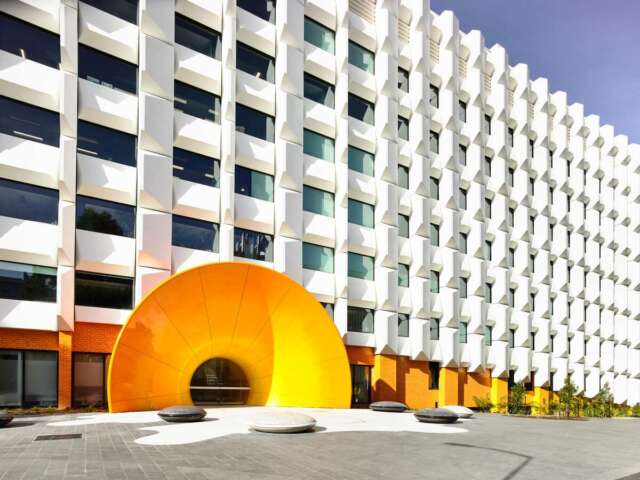Designed by Kosloff Architecture, the Monash School of Biological Science project embraces environmental responsibility to adapt existing building stock.
In doing so, the Kosloff Architecture team addressed the question of what it means to re-skin an existing 1960’s modernist building in a contemporary manner.
The project was undertaken as a collaboration between Kosloff Architecture, artist Callum Morton, and Monash Art Projects (MAP).
Norman Disney & Young (NDY), Wood and Grieve Engineers (now Stantec), and Arup were also involved from conception until completion.
Collectively, the focus was to deliver a building that performed exceptionally well environmentally, with upgraded services to future-proof capability, and an enduring outcome that contributed to the university’s public art strategy.
Nineteen other specialist consultants also contributed their expertise.
Located on Innovation Walk, the existing building sits alongside several other modernist buildings of the same era, as well as more contemporary additions.
Conceived as a ‘curtain’, the new façade hangs from above and is lifted at various points along the ground plane to allow a glimpse behind an array of custom coloured glazed bricks at the pedestrian level.
Entry into the building is through a portal designed in collaboration with the artist Callum Morton.
Curving in two directions, it draws on the artifacts of scientific research processes to provide passage to a ground floor gallery showcasing part of the extensive Monash University art collection.
The building houses the biology and psychology faculties including a variety of spaces including a lecture theatre, classrooms, laboratories, offices, and administration facilities, all of which remained in use throughout the re-skinning process.
The building and its surroundings remained fully operational throughout construction and none of the occupants were decanted during the façade replacement works.
Ongoing scientific experiments with plants and animals continued uninterrupted.
A construction sequencing and installation methodology were devised to enable the entire existing facade (brick and windows) to remain in place while the new facade was constructed over.
It was only at completion, that the existing windows and walls were demolished from the inside to reveal the new, high-performance façade.
Feasibility reports that were undertaken prior to commencement estimated that a new equivalent building would cost significantly more compared to the façade replacement.
Avoiding the cost of decanting, relocation, and disruption of ongoing science experiments alone saved the university close to $2,000,000.
Baselining of the existing building’s environmental performance was completed prior to commencement and repeated at the end of each design phase to track improvement.
The final outcome was a new façade that performed significantly better than BCA Section J 2017, greater than 40% improvement at controlling solar gain than the original, and a reduction in cooling demand by more than 20%.
This project began in response to the deterioration of the existing 1960’s brick façade.
While Kosloff Architecture’s commission was for this building, their design team was interested in developing a strategy that could be applied across many similar campus buildings.
This evolved into a strategy for public art integration, significant improvement of the performance of the building skin, and future-proofing the entire building through upgrading its services infrastructure.
Project Details
Project Size – 11,000 m2
Site Area – 11,000m2
Completion Date – 2018
Building Levels – 9
Project Team
Architecture
Kosloff Architecture
Kosloff Architecture believes that in order to build a highly engaged practice culture, they need to be willing to challenge existing ideas regarding ownership, succession planning, career trajectories, and modes of working.
Landscape Architecture
Rush Wright Associates
Rush Wright Associates is an award-winning design practice based in Melbourne, Australia, offering consultancy services in landscape architecture, urban design, and constructed ecology.
Artist
Monash Art Projects (MAP)
MAP is a collaborative studio that seeks to transform how we think of art in the public sphere, recognising the predominance of visual forms of media, communication, and information in the contemporary world.
www.monash.edu/mada/research/labs/monash-art-projects
Callum Morton
Professor Callum Morton of Monash University has exhibited nationally and internationally since 1990.
www.monash.edu/mada/about-us/people/callum-morton
Photography
Derek Swalwell
Derek is an architectural and editorial photographer from Melbourne, Australia. His name is synonymous with the photographic representation of the architectural landscape in Australia and beyond.
Photo Gallery
Click on a thumbnail image to enlarge.
Design © 2022 Kosloff Architecture. All Rights Reserved.| Images © 2022 Derek Swalwell. All Rights Reserved.
The Builtworks Quest
At Builtworks, we’re on a multi-year quest to document, showcase, and spotlight the best of Australia’s built environment.
That’s why we’re creating this comprehensive online archive and educational resource that showcases a diverse and eclectic range of project types and scales.
Together with showcasing older exemplars of enduring merit, we spotlight and celebrate new and recent additions to Australia’s built environment.












